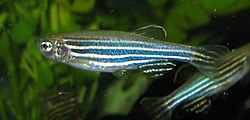What can Zebrafish tell us about metastatic melanoma?
This week’s Nature is chock full of interesting articles on various cancer related topics so it was quite hard to pick just one to discuss in a blog post. Nevertheless, two on Zebrafish was very striking, since the Letters discusses how models have revealed oncogenes and potential new drug targets in a particularly difficult to treat tumour type, i.e. melanoma.
We now know that in melanoma, the BRAF V600E mutation drives signaling and proliferation of the MAPK pathway and that resistance also develops to treatment with targeted therapies such as PLX4032 and other inhibitors after six months or so. The question then is what factors are driving the resistance and are other (druggable) oncogenes involved?
A multinational group of researchers from Boston, Rome and Paris used Zebrafish melanoma models to explore events in a:
“Recurrently amplified region of chromosome 1 for the ability to cooperate with BRAF(V600E) and accelerate melanoma.”
In doing so, they discovered something very interesting:
“SETDB1, an enzyme that methylates histone H3 on lysine 9 (H3K9), was found to accelerate melanoma formation significantly in Zebrafish.”
Chromatin was also found to be involved in tumorigenesis associated with SETDB1.
Histone methylation has been mooted as a promotor of cancer in other tumour types such as renal cell carcinoma and others, thus this study lends support to that theory.
In the second letter, White et al., (2011) report that DHODH inhibition with either leflunomide and NSC210627 led to a marked decrease in melanoma growth, both in vivo and in a xenograft model. They used the Zebrafish to successfully identify:
“Small molecule suppressors of neural crest progenitors that give rise to melanoma.”
What do these findings mean?
SETDB1 is focally amplified in a number of malignancies, which means that it would be interesting to see if it also promotes histone methyltransferase activity in other cancers too.
The results from the Letters to Nature suggest that both DHODH and SETBD1 could be valid new targets for therapeutic intervention if drugs could be designed and developed to shut down the activity and prevent acceleration of the disease. Future new logical combinations or sequencing of therapies in melanoma could therefore emerge from these important research findings.
In addition…
If you haven’t taken a look yet, this weeks Nature magazine is well worth reading for several other useful articles on cancer that are related to research including vaccines, biomarkers, liver cancer, genome sequencing in multiple myeloma, FAS and NF-kB signalling in lung cancer. There is also a whole Outlook section (open access) on Cancer Prevention that is relatively easy to read, even for the layman that is worth checking out.
References:
![]() Ceol, C., Houvras, Y., Jane-Valbuena, J., Bilodeau, S., Orlando, D., Battisti, V., Fritsch, L., Lin, W., Hollmann, T., Ferré, F., Bourque, C., Burke, C., Turner, L., Uong, A., Johnson, L., Beroukhim, R., Mermel, C., Loda, M., Ait-Si-Ali, S., Garraway, L., Young, R., & Zon, L. (2011). The histone methyltransferase SETDB1 is recurrently amplified in melanoma and accelerates its onset. Nature, 471 (7339), 513-517 DOI: 10.1038/nature09806
Ceol, C., Houvras, Y., Jane-Valbuena, J., Bilodeau, S., Orlando, D., Battisti, V., Fritsch, L., Lin, W., Hollmann, T., Ferré, F., Bourque, C., Burke, C., Turner, L., Uong, A., Johnson, L., Beroukhim, R., Mermel, C., Loda, M., Ait-Si-Ali, S., Garraway, L., Young, R., & Zon, L. (2011). The histone methyltransferase SETDB1 is recurrently amplified in melanoma and accelerates its onset. Nature, 471 (7339), 513-517 DOI: 10.1038/nature09806
White, R., Cech, J., Ratanasirintrawoot, S., Lin, C., Rahl, P., Burke, C., Langdon, E., Tomlinson, M., Mosher, J., Kaufman, C., Chen, F., Long, H., Kramer, M., Datta, S., Neuberg, D., Granter, S., Young, R., Morrison, S., Wheeler, G., & Zon, L. (2011). DHODH modulates transcriptional elongation in the neural crest and melanoma Nature, 471 (7339), 518-522 DOI: 10.1038/nature09882
